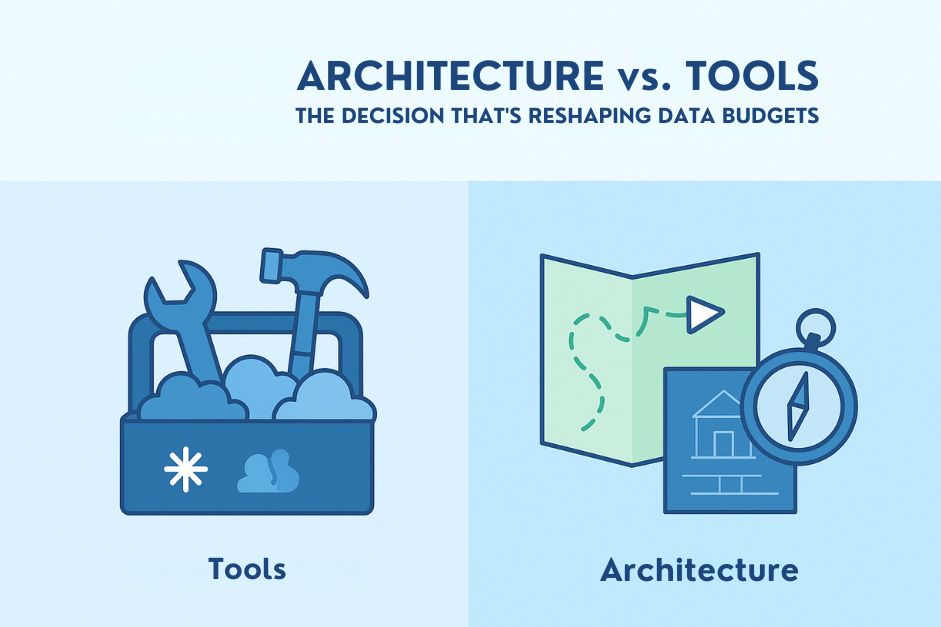#033 - The ETL vs ELT Choice That's Costing Teams Millions (Free Framework Inside)
The architecture decision that makes or breaks your data modernisation budget
Hey there,
In my 15 years across three continents, I've watched this same scene play out dozens of times.
A team spends months evaluating tools, running proofs-of-concept, and comparing vendor feature lists. They pick what looks like the obvious choice based on "best practices."
Then reality hits. The architecture doesn't align with their actual constraints.
Costs spiral.
Performance suffers.
Teams get frustrated.
Here's what I've learned: Most teams are solving the wrong problem entirely.
They're choosing between tools when they should be choosing between architectures. And that decision determines whether you'll save money or struggle with escalating costs for years.
Coming from a world of complex Teradata migrations to modern Snowflake and BigQuery deployments, I've seen both the spectacular wins and the expensive mistakes. The difference? Teams that think through architecture before they fall in love with specific tools.
In this week's issue:
Why the ETL vs ELT choice is more critical than ever in 2025
The 5-question framework I use to evaluate architecture decisions
Free decision tree based on patterns I've seen across industries
What I wish I'd known when I started these migrations
Let's dive in...
The Architecture Decision That's Reshaping Data Budgets
The ETL vs ELT conversation has fundamentally changed since I started doing these migrations.
What's different now:
Cloud data warehouses have completely shifted the cost equation. When I was working with traditional on-premise systems, the choice was mostly about processing power and compliance. Now? It's about where your compute costs hit and how your team scales.
The patterns I'm seeing:
Most new cloud deployments default to ELT without thinking through the implications
Regulated industries still lean heavily on ETL, often out of habit rather than necessity
The cost difference between aligned and misaligned approaches can be massive
But here's the challenge: Most decision frameworks I see are still built for the on-premise world. They don't account for cloud economics, real-time demands, or how modern analytics workloads behave.
The result? Teams are making architecture choices based on outdated criteria and living with the consequences for years.
Why "Best Practice" Advice Often Misses the Mark
The conventional wisdom goes like this: "Use ETL for complex transformations and compliance. Use ELT for big data and analytics."
In my experience, that advice oversimplifies the fundamental decision factors.
After working through migrations at major financial institutions and retail organisations, I've noticed that the choice depends on five factors that traditional advice often ignores:
Where your compute costs land
How your team's existing skills align with ongoing maintenance
What your data volume trajectory looks like
Where your compliance requirements create genuine bottlenecks
How your source systems are likely to evolve
I've seen organisations choose "best practice" ETL and struggle with cloud compute costs they didn't anticipate. I've also seen teams adopt "modern" ELT, only to struggle with compliance processes that weren't designed for that approach.
The real question isn't ETL vs ELT. It's: Which architecture fits your specific situation and growth path?
A Framework Based on What I've Learned
After working through these decisions across different industries and continents, I've started using five key questions to cut through the complexity. This isn't a perfect formula, but it's helped me think more clearly about architecture choices.
Question 1: Where Does Your Data Live?
What I've noticed:
Cloud-native sources (Salesforce, APIs, SaaS tools) → ELT often makes more sense
On-premise databases in hybrid environments → ETL is frequently easier to manage
Mixed environments with heavy compliance → Usually need a thoughtful hybrid approach
Why this matters: Data gravity is real. Every time you move data to transform it, you're paying for that movement.
Question 2: What's Your Volume and Growth Reality?
Patterns I've seen:
Smaller volumes with predictable schedules → ETL often cost-effective and simpler
Large volumes with frequent updates → ELT usually handles this better
Rapid growth trajectories → Better to plan for ELT scalability early
The trap: Teams often design for current needs without considering where they'll be in 18 months.
Question 3: What Are Your Transformation and Governance Needs?
From my experience:
Straightforward aggregations and cleaning → ELT handles this well
Complex business logic with multiple validation rules → ETL often gives you better control
Analytics and ML workloads → ELT with warehouse compute usually wins
Governance considerations:
Heavy audit requirements → ETL can be easier to track and control
Self-service analytics needs → ELT typically enables faster access
Question 4: What's Your Team's Actual Skill Set?
What I've observed:
Strong SQL and cloud experience → ELT leverages what they already know
Traditional ETL background → Transitioning gradually might be smarter
Small teams needing low maintenance overhead → Managed services often make sense
Hidden reality: Retraining isn't just about time—it's about months of reduced productivity while people learn new approaches.
Question 5: What's Your True Total Cost?
Factors I always consider:
Set up and migration investment
Ongoing compute and storage costs
Maintenance and monitoring overhead
Team training or hiring needs
Compliance and audit effort.
This last one often surprises teams. The "cheaper" option on paper sometimes costs significantly more when you factor in the whole operational picture.
What I Wish I'd Known Earlier
Looking back on migrations I've been part of, here are the insights I wish I'd had from the start:
Architecture beats features every time. The teams that succeed aren't using the "best" tools; they're using the right approach for their specific constraints.
Your source systems matter more than you think. If 80% of your data is already in the cloud, fighting that gravity with ETL is often expensive and complex.
Team capabilities are a fundamental constraint. The most elegant architecture fails if your team can't operate it effectively.
Compliance doesn't automatically mean ETL. Many regulatory requirements can be met with ELT if you design the monitoring and audit trails correctly.
Growth changes everything. What works at 100GB often breaks at 10TB; plan for where you're going, not just where you are.
Your 5-Question Decision Framework (Free)
I've turned these insights into a simple framework you can use to think through architecture decisions.
What you get:
✅ Structured worksheet with all five questions and guidance
✅ Decision criteria based on patterns I've seen work
✅ Cost consideration checklist for realistic planning
✅ Risk factors to watch out for during implementation
This isn't a magic formula; every situation is different. But it's the thinking process I use to cut through vendor pitches and get to what matters for your specific context.
Get the framework: Reply with "FRAMEWORK" and I'll send you the complete toolkit.
The Bottom Line: Think Architecture First
After 15 years of data transformations, here's what I've learned:
The organisations that succeed make architecture decisions based on their real constraints and growth trajectory, not generic best practices.
The ones that struggle are often fighting their own technical choices because they optimised for the wrong factors.
Your ETL vs ELT choice will impact your costs, team productivity, and ability to adapt for years. It's worth thinking through carefully.
Want the decision framework? Reply "FRAMEWORK" for the complete toolkit.
Have an architecture question? Hit reply and tell me about your situation. I read every email, and your questions often inspire future content.
Talk soon,
Khurram
P.S. If this resonates with your experience, please forward it to a colleague who's working through similar decisions. These architectural choices are too important to guess at.
Want more like this? Hit reply and let me know what data engineering topics you want me to dive into next.





Great insights,
What resonated most is how you tie the architecture choice directly to team skills, governance, and data gravity. I’ve seen teams default to ELT because it feels modern, only to get blindsided by compliance bottlenecks or runaway compute costs. Your framework is refreshing because it’s practical, not prescriptive. Every environment has different trade-offs, and your approach helps teams surface those early rather than learning the hard way.
FRAMEWORK